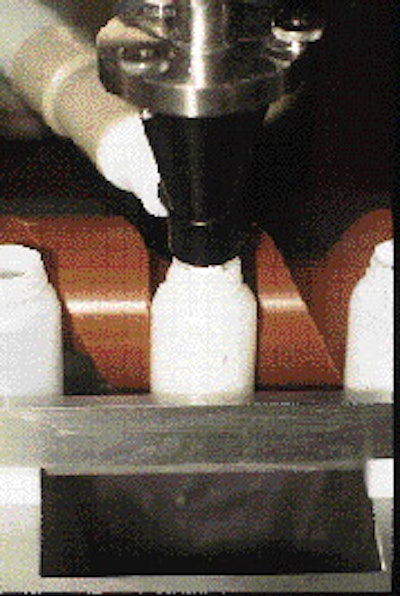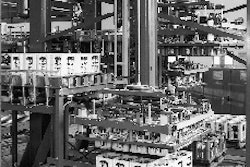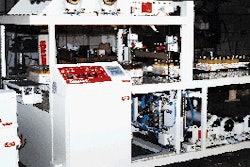When pharmaceutical manufacturer Apotex Inc. developed a line of sugar-free antibiotic suspension products for children who have difficulty ingesting sugar, it decided its existing packaging equipment wasn't up to speed. Or accuracy. Much like sugar substitutes sold to consumers, only a tiny amount of the powdered sweetener is needed to equal the sweetness of sugar. Therefore, for the new sugar-free line, Apotex required a filler that could accurately dispense tiny quantities of product, as well as fill its existing line of sugar-based suspension products. It began production in April of this year. "The old formulations [sugar-based products] are between 22.5 to 100 grams," says Joe Manias, director of production at Weston, Ontario, Canada-based Apotex, "while the new formulations range from 3.27 to 12.4 grams." These penicillin-based antibiotics are dispensed into polyethylene bottles (with high-density polyethylene child-resistant closures) and sold to pharmacies and hospitals. Four varieties of each of the sugar-free and sugar-based products are available in three sizes, for a total of 24 products, using five sizes of bottles: 60, 75, 100, 150 and 200 mL. At the time of purchase, a pharmacist adds water to the powder and shakes it thoroughly to create the "suspension." They're sold to consumers as prescription-only liquid antibiotics, with instructions for the consumer to keep products refrigerated and to shake well before use. Refrigerated shelf life is 14 days. Dosing danger With Apotex's original products, tare weight was determined by averaging the weight of 20 random bottles and then subtracting that amount from the average weight of an equal number of filled bottles. However, says Manias, "Sometimes the bottle weights varied widely and I had to go back to the bottle manufacturer to resolve weight variation issues." Manias says that product giveaway with the old line was always minimal: ±1% or 2%, but with the minute weights of the sugar-free line, even those variations were too risky. "This is a drug," he stresses. "We have to be very accurate. "We had looked at several manufacturers and there were a lot of things we compared. Price and accuracy were number one. Other manufacturers wouldn't guarantee the accuracy. They didn't want to get into it," Manias explains. The company finally found Spee-Dee Packaging Machinery (Sturtevant, WI), which offered them a Model 2000 Digitronic Auger® Pharmaceutical Net Weigh System equipped with two Icore checkweighers from Ramsey (Minneapolis, MN). This combination provides filling accuracies of ±0.15 g, compared to the previous system's average of ±1.5 g. Manias takes Packaging World through the line: After upright bottles are cleaned and oriented, they proceed via flatbed conveyor to the "pre-tare station," where empty bottles are individually weighed. Bottles then enter a feedscrew and convey to a dosing station where they're filled one-up. Under the dosing head, a short dwell time allows for filling. To minimize dusting, a dust shroud surrounds the dosing head. It's equipped with a vacuum hose that removes any particulates from the air. Previous speeds were 30-35 bottles/min, says Manias; now they are almost double that. After filling, bottles proceed to the final checkweighing station, where they are weighed. The checkweighers operate with what is called a "feedback loop." There, the tare weight is subtracted from the weight of the full bottles. "The difference must be within parameters we set," says Manias. "If it's off target, it will feed back to the microprocessor controller to increase or decrease the number of revolutions [of the auger]. The machine is accurate to 1/800ths of a revolution." Bottles not within the parameters are rejected via an air-actuated cylinder that pushes bottles out of the feedscrew and into a holding area. Next, bottles are capped using an existing in-line capper. They then proceed via a slat conveyor to the labeling station where labels are applied. A machine vision inspection system verifies label presence and lot number and expiration dates. Bottles are shrink wrapped in bundles of 12, sent through a shrink tunnel, then loaded onto a pallet and warehoused. Quick changeovers Changeover time has been reduced by 40%, says Manias. "When we purchase a new piece of equipment we know what we're after," he says. "We made sure it had quick changeover features. Tooling requirements? Maybe one or two pieces maximum. Anything that's threaded we try to avoid. Quick-release is really what we're after." Running one shift per day, five days a week, Apotex changes its line about every other day. "It's easily changed," says Manias. "There's a 'recipe' with all of our parameters [already programmed into the control]. You push a button, and it's all ready to go. "For the actual change parts," he continues, "there's around a 10-minute change. The auger and a few other change parts have to be changed. Because the bottles are different heights, the filling head has to be adjusted, then the guide rails have to be adjusted. We went through a customization where we marked the position of the rails with respect to bottles. Because we have five different-size bottles, we can just go to that reference mark and away we go." Quick-disconnect guide rails are tightened using knobs. Speedy advantages "What I like about the machine," says Manias, "is the touchscreen control panel. You can change the parameters of the machine by touching the screen. You don't even have to use the keyboard. No other machinery builder that I knew of had that at the time." Coupled with a PC, the computer control allows on-screen adjustments of auger functions including revolutions, speed and acceleration. Changes to the line configuration to accommodate the new equipment were minimal, says Manias. "We had to cut the line to fit the checkweigher in," he says. "We removed some conveyor and rearranged the line. We have a lot of good packaging mechanics inside our plant at Apotex [that helped facilitate the change]." Manias says that in launching a new product line, investment was inevitable. But savings come in other forms. Because the line is faster and changeovers are quicker, overtime shifts have been eliminated. Overall, says Manias, "It's a much smoother operation. Changeovers are quicker, I like the touch-screen graphics, it's very accurate and the repeatability is very good. The repeatability shows just how smoothly the machine runs.... Overall, I have no problems with the system."



























